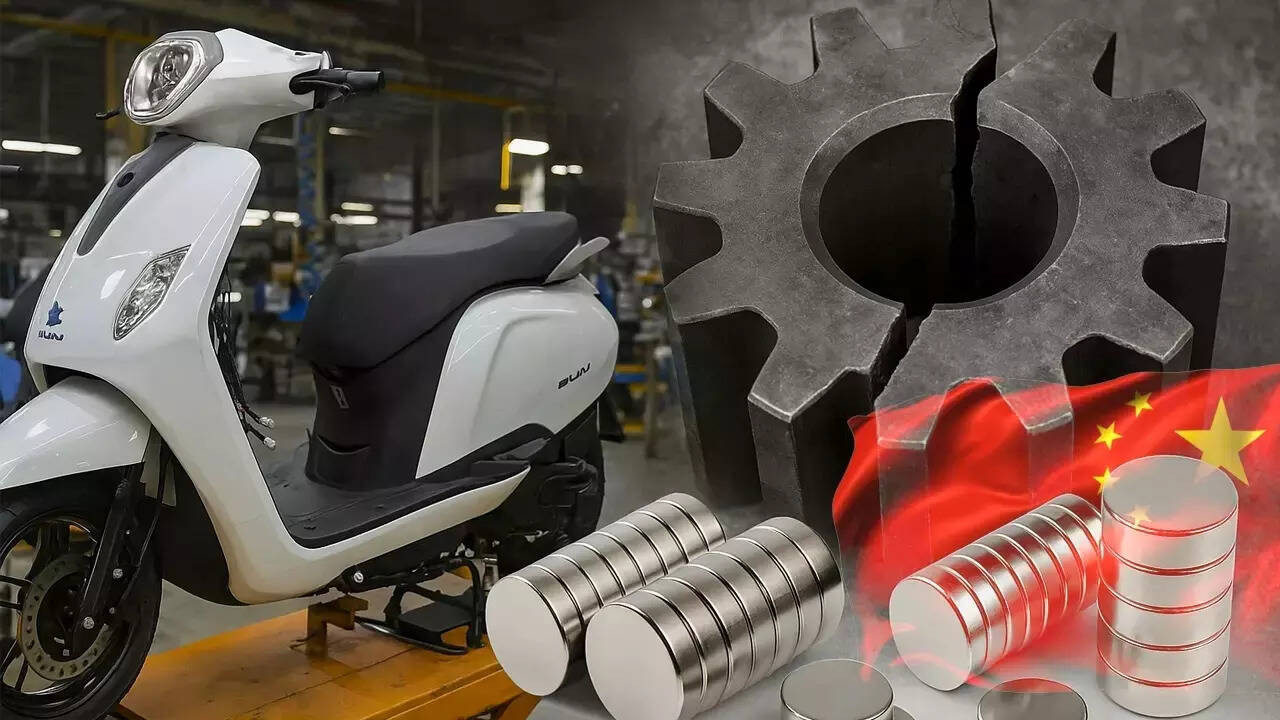Bajaj Auto has ensured a sufficient supply of rare earth magnets and other crucial materials, securing production for the festive season. Demand for their Chetak electric scooter remains strong, with deliveries now underway as supplies normalize.
Bajaj Chetak Rides Again: Rare Earth Magnet Supply Chain Revs Back Up
For a while there, the future of Bajaj’s stylish electric scooter, the Chetak, looked a little uncertain. Back in May, Rajiv Bajaj, Managing Director of Bajaj Auto, painted a stark picture: a potential “zero production month” loomed, all thanks to a global crunch on a seemingly obscure, yet vital component – rare earth magnets. These magnets are the unsung heroes powering everything from electric vehicle motors to wind turbines, and a snag in their supply chain sent ripples across industries worldwide.
But hold that doomsday scenario! The good news is, the Chetak is back on track. Bajaj Auto has successfully navigated the storm, securing the necessary supply of rare earth magnets and resuming production of its flagship e-scooter. What exactly happened, and why was this particular type of magnet such a problem in the first place? Let’s dig in.
The global supply chain, particularly for specialized components like these magnets, is a complex web. Rare earth elements, the raw materials needed to manufacture them, are predominantly mined and processed in China. Geopolitical tensions, pandemic-related disruptions, and increased demand all contributed to a perfect storm, squeezing the availability and driving up prices. For companies like Bajaj Auto, heavily reliant on a steady stream of these magnets for their electric vehicle production, the impact was significant. Imagine designing a brilliant electric scooter, gearing up for production, only to be stalled by a shortage of something most consumers have never even heard of!

The issue wasn’t simply about any magnet; it was about the specific properties and performance of rare earth magnets that made them essential for the Chetak. These magnets offer exceptional strength and efficiency in a compact size, crucial for maximizing the power and range of an electric vehicle. Swapping them out for alternatives would likely mean compromising performance, increasing weight, or redesigning significant parts of the motor. Therefore, finding a solution wasn’t just about sourcing magnets; it was about finding magnets that met the precise technical specifications of the Chetak.
So, how did Bajaj pull it off? While the company hasn’t publicly detailed the specifics of their strategy, it likely involved a multi-pronged approach. This could include:
* Diversifying Supply Sources: Exploring alternative suppliers beyond the primary source to reduce dependence on a single region. This can be a long process, requiring careful vetting and qualification of new vendors.
* Negotiating Long-Term Contracts: Securing commitments from existing suppliers for a guaranteed volume of magnets, providing more predictable supply and potentially shielding against price fluctuations.
* Investing in Domestic Manufacturing: While a longer-term solution, investing in or partnering with domestic manufacturers of rare earth magnets would provide greater control over the supply chain and reduce reliance on imports. India is actively working on developing its own rare earth processing capabilities, which could offer significant benefits to manufacturers like Bajaj Auto in the future.
The resumption of Chetak production is welcome news not only for Bajaj Auto but also for the broader Indian electric vehicle market. It demonstrates resilience in the face of global supply chain challenges and highlights the growing importance of strategic sourcing and diversification. This isn’t just about one scooter; it’s about securing a sustainable future for India’s burgeoning EV industry.
Moreover, the situation underscores the critical role of government policy in supporting domestic manufacturing of key components. Incentives, infrastructure development, and streamlined regulatory processes can all play a vital role in attracting investment and building a robust local supply chain.
The bumpy ride for the Chetak serves as a valuable lesson for the entire industry. As electric vehicles become increasingly mainstream, securing the supply of essential components like rare earth magnets will be paramount. It’s a reminder that even the most innovative products depend on a complex global network, and proactive risk management is essential for navigating potential disruptions. Now that the supply chain is revving back up, we can expect to see more Chetaks on the road, contributing to a greener and more sustainable future for Indian transportation.
[Here’s how the Indian government is supporting the EV transition](https://example.com/india-ev-policy).
In conclusion, the resolution of Bajaj’s rare earth magnet supply issues offers a beacon of optimism. It showcases adaptability and strategic foresight in the face of global challenges, reaffirming the potential for growth and sustainability within India’s dynamic electric vehicle sector. The Chetak’s resurgence symbolizes a broader movement towards securing resilient supply chains and fostering a self-reliant ecosystem for the future of electric mobility.







